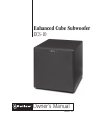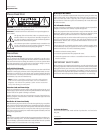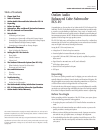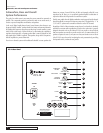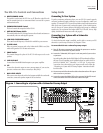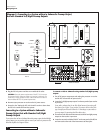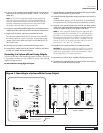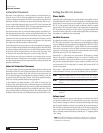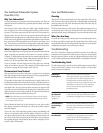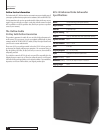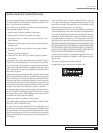
8
Outlaw Audio
Owner’s Manual
Subwoofer Placement
Placement of your subwoofer is a critical component in maximizing the per-
formance of your ECS-10. Placement influences the subwoofer’s “perceived”
frequency response, sound pressure level (SPL), and overall accuracy. Since each
listening room differs in virtually every aspect, the ideal location will also vary.
An easy way to find the right spot to place your new ECS-10 is to experiment with
what we call the “Subwoofer Switch Trick”. This process puts the subwoofer where
you normally sit and then lets you play the role of the subwoofer.
Place the subwoofer as close to your favorite listening position as possible. If pos-
sible, place the unit in front of your couch or easy chair, right in the room’s “sweet
spot”. Provided that there is no damage to your furniture, you may even place the
subwoofer on the chair or couch, but remember that the ECS-10 is heavy, and the
Outlaws are not responsible for any damage to your furniture or for arguments
this might cause with other members of the household!
Activate the test tone from your processor or receiver’s internal test tone generator,
or use your favorite test disc so that pink noise plays through the subwoofer .While
the test tone is playing, walk around your room to find the spots where you hear
the best bass response. Sometimes this may be in the center of the room, while
in other cases you may find the best spot in a corner or along a side wall.
Turn off the test tone and move the subwoofer to the location where you hear
the best bass response. If that location is unacceptable or impractical, repeat the
procedure to the spot that is the best compromise between bass performance and
aesthetic considerations.
Notes On Subwoofer Placement
Try to avoid creating a listening position that falls directly between the front and
back walls and this may cause a strong interference effect due to the collision
between bass waves bouncing off the rear wall and new bass waves from the
ECS-10. When this happens you might hear an unnatural “build up” in the low
frequencies where the bass sounds “bloated”, based on the specific dimensions
of the room and the particular frequency being reproduced.
In other situations you might encounter a “null”, which is caused by two low
frequency waves canceling each other out. When this happens you will find that
your favorite listening position is bass shy. In this type of placement situation bass
response will suffer greatly regardless of how powerful the subwoofer is. The best
way to solve this problem is to change the location of the seating position so that
the distance to the front of the room is different than that to the back of the room.
Setting the ECS-10’s Controls
Phase Switch
Depending on the absolute phase of your main speakers and amplifier, as well as
the relative distance from the ECS-10 and main speakers to the listening position,
the bass in the crossover region may be smoother if you reverse the phase of the
ECS-10. Try both positions of the phase switch to determine which way sounds
more bass-heavy. The bass-heavier position is the setting where the output of the
ECS-10 and the main speakers are most in phase. Use program materials with
bass in the crossover region such as music containing bass drums, double basses,
bass guitar, etc. to determine the correct setting.
Variable Crossover
By adjusting the variable crossover on the ECS-10, you can perfectly match the
ECS-10 to your main speakers. If your receiver or processor already has a built in
crossover, disable the crossover on the ECS-10 by flipping the “LOW-PASS X-OVER”
switch to the “SUBWOOFER DIRECT” position. Refer to the owner’s manual for
your receiver or processor to see how to disable any internal crossover capability
it may have. If your receiver or processor does not have internal crossover control,
follow these steps to set ECS-10’s variable crossover:
Determine the +/- 3dB point of your main speakers. This frequency is usually
found on the speaker’s specifications sheet or may often be available on the
speaker manufacturer’s web site. Start with the crossover set approximately to
this point. By experimenting with the crossover frequency and level control, you
can fine-tune the ECS-10 so that there is a seamless link between the ECS-10
and the main speakers.
If the actual +/- 3dB point cannot be obtained from the speakers’ specifications
or the manufacturer’s web site, you can use the following chart as a guideline:
40 Hz
Large tower speaker with one 12 or 15-in. woofer or two 10-in. woofers;
Small tower speaker with one 10-inch woofer or two 8-inch woofers
60 Hz Small tower or large bookshelf speaker with one 8-in. or two 6-in.
woofers
80 Hz Bookshelf speaker with one 6-in. or two 5-in. woofers
100 Hz Bookshelf speaker with one 5-in. woofer or two 4-in. woofers
120 Hz Satellite speaker with one 4-in. woofer or one or two 3.5-in.
woofer(s)
Volume Level
Using the built-in test tones of your receiver/processor, match the levels of all of
your speakers including the ECS-10 as described in your receiver or processor’s
owner’s manual. A setting of 5 on the ECS-10’s volume knob should provide enough
gain to properly match the sub level to your speakers. We recommend using an
SPL meter such as the Radio Shack (part number 33-2050). When using the test
tones, measure from the listening chair and set the meter to the 75 dB level. In
order to accurately measure levels between channels use “C” weighting and the
“slow” setting.
Note: The Radio Shack meter is down about 12 dB at 16 Hz, 7 dB at 20
Hz, and 4 dB at 25 Hz. Add these numbers to the readout to compensate
for these errors if necessary.
Subwoofer Placement



